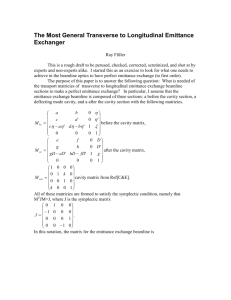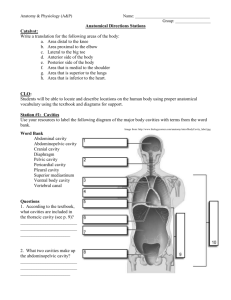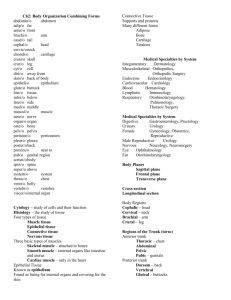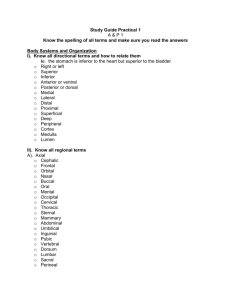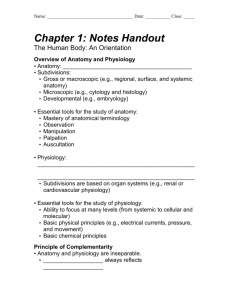ECSS-E-HB-31-01 - European Cooperation on Space Standardization (ECSS)
advertisement
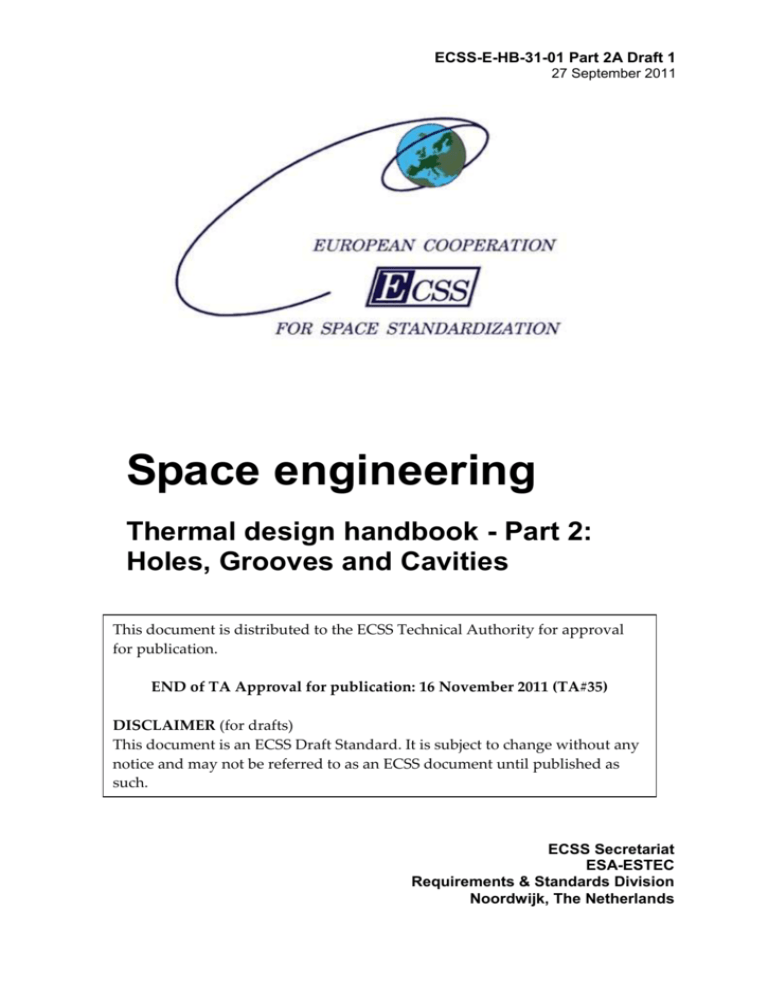
ECSS-E-HB-31-01 Part 2A Draft 1 27 September 2011 Space engineering Thermal design handbook - Part 2: Holes, Grooves and Cavities This document is distributed to the ECSS Technical Authority for approval for publication. END of TA Approval for publication: 16 November 2011 (TA#35) DISCLAIMER (for drafts) This document is an ECSS Draft Standard. It is subject to change without any notice and may not be referred to as an ECSS document until published as such. ECSS Secretariat ESA-ESTEC Requirements & Standards Division Noordwijk, The Netherlands ECSS-E-HB-31-01 Part 2A Draft 1 27 September 2011 Foreword This Handbook is one document of the series of ECSS Documents intended to be used as supporting material for ECSS Standards in space projects and applications. ECSS is a cooperative effort of the European Space Agency, national space agencies and European industry associations for the purpose of developing and maintaining common standards. The material in this Handbook is a collection of data gathered from many projects and technical journals which provides the reader with description and recommendation on subjects to be considered when performing the work of Thermal design. The material for the subjects has been collated from research spanning many years, therefore a subject may have been revisited or updated by science and industry. The material is provided as good background on the subjects of thermal design, the reader is recommended to research whether a subject has been updated further, since the publication of the material contained herein. This handbook has been prepared by ESA TEC-MT/QR division, reviewed by the ECSS Executive Secretariat and approved by the ECSS Technical Authority. Disclaimer ECSS does not provide any warranty whatsoever, whether expressed, implied, or statutory, including, but not limited to, any warranty of merchantability or fitness for a particular purpose or any warranty that the contents of the item are error-free. In no respect shall ECSS incur any liability for any damages, including, but not limited to, direct, indirect, special, or consequential damages arising out of, resulting from, or in any way connected to the use of this document, whether or not based upon warranty, business agreement, tort, or otherwise; whether or not injury was sustained by persons or property or otherwise; and whether or not loss was sustained from, or arose out of, the results of, the item, or any services that may be provided by ECSS. Published by: ESA Requirements and Standards Division Copyright: ESTEC, P.O. Box 299, 2200 AG Noordwijk The Netherlands 2011 © by the European Space Agency for the members of ECSS 2 ECSS-E-HB-31-01 Part 2A Draft 1 27 September 2011 Table of contents 1 Scope ....................................................................................................................... 5 2 References .............................................................................................................. 6 3 Terms, definitions and symbols ............................................................................ 7 3.1 Terms and definitions ............................................................................................... 7 3.2 Symbols .................................................................................................................... 7 4 Gray diffuse surfaces ............................................................................................. 8 4.1 General..................................................................................................................... 8 4.2 Diffuse incident radiation......................................................................................... 11 4.2.1 V-groove ................................................................................................... 11 4.2.2 Parallel-walled groove ............................................................................... 12 4.2.3 Circular-arc groove.................................................................................... 13 4.2.4 Axisymmetrical conical cavity .................................................................... 14 4.2.5 Circular cylindrical cavity ........................................................................... 15 4.2.6 Spherical cavity ......................................................................................... 16 Bibliography............................................................................................................. 18 Figures Figure 4-1: Apparent emittance, a , of differently shaped isothermal cavities, all of them having gray diffuse emitting and reflecting surfaces, as a function of the opening to cavity area radio, Ah/Ac , for several values of the surface emittance, . Calculated by the compiler. ........................................................... 10 Figure 4-2: Apparent emittance, a, of a V-groove vs. angle , for different values of the surface emittance, . Calculated by the compiler. ............................................... 11 Figure 4-3: Apparent emittance, a, of a parallel-walled groove vs. dimensionless depth, H, for different values of the surface emittance, . Calculated by the compiler. ............................................................................................................ 12 Figure 4-4: Apparent emittance, a, of a circular – arc groove vs. opening semiangle, , for different values of the surface emittance, . Calculated by the compiler. ....... 13 Figure 4-5: Apparent emittance, a, of a conical cavity vs. cone angle, , for different values of the surface emittance, . Calculated by the compiler. .......................... 14 3 ECSS-E-HB-31-01 Part 2A Draft 1 27 September 2011 Figure 4-6: Apparent emittance, a, of a cylindrical cavity vs. dimensionless depth, H, for different values of the surface emittance, . Calculated by the compiler. ....... 15 Figure 4-7: Apparent absorptance, a, of a spherical cavity vs. opening semiangle, , for different values of the surface absorptance, . Calculated by the compiler. ............................................................................................................ 17 4 ECSS-E-HB-31-01 Part 2A Draft 1 27 September 2011 1 Scope In this Part 2 of the spacecraft thermal control and design data handbooks, the radiant heat transfer properties of cavities that do not contain an absorbing-emitting medium are analyzed. The effect of radiant energy entering a cavity with one or more openings is discussed taking into consideration the characteristics and properties of the constituents. Examples support the solutions discussed. The Thermal design handbook is published in 16 Parts ECSS-E-HB-31-01 Part 1 Thermal design handbook – Part 1: View factors ECSS-E-HB-31-01 Part 2 Thermal design handbook – Part 2: Holes, Grooves and Cavities ECSS-E-HB-31-01 Part 3 Thermal design handbook – Part 3: Spacecraft Surface Temperature ECSS-E-HB-31-01 Part 4 Thermal design handbook – Part 4: Conductive Heat Transfer ECSS-E-HB-31-01 Part 5 Thermal design handbook – Part 5: Structural Materials: Metallic and Composite ECSS-E-HB-31-01 Part 6 Thermal design handbook – Part 6: Thermal Control Surfaces ECSS-E-HB-31-01 Part 7 Thermal design handbook – Part 7: Insulations ECSS-E-HB-31-01 Part 8 Thermal design handbook – Part 8: Heat Pipes ECSS-E-HB-31-01 Part 9 Thermal design handbook – Part 9: Radiators ECSS-E-HB-31-01 Part 10 Thermal design handbook – Part 10: Phase – Change Capacitors ECSS-E-HB-31-01 Part 11 Thermal design handbook – Part 11: Electrical Heating ECSS-E-HB-31-01 Part 12 Thermal design handbook – Part 12: Louvers ECSS-E-HB-31-01 Part 13 Thermal design handbook – Part 13: Fluid Loops ECSS-E-HB-31-01 Part 14 Thermal design handbook – Part 14: Cryogenic Cooling ECSS-E-HB-31-01 Part 15 Thermal design handbook – Part 15: Existing Satellites ECSS-E-HB-31-01 Part 16 Thermal design handbook – Part 16: Thermal Protection System 5 ECSS-E-HB-31-01 Part 2A Draft 1 27 September 2011 2 References ECSS-S-ST-00-01 ECSS System - Glossary of terms All other references made to publications in this Part are listed, alphabetically, in the Bibliography. 6 ECSS-E-HB-31-01 Part 2A Draft 1 27 September 2011 3 Terms, definitions and symbols 3.1 Terms and definitions For the purpose of this Standard, the terms and definitions given in ECSS-S-ST-00-01 apply. 3.2 Symbols Ac surface area of the cavity, [m2] Ah area of the surface tightly stretched over the cavity opening, [m2] TW cavity wall temperature, [K] Ti surrounding temperature facing the ith opening, [K] hemispherical total absorptance of a surface hemispherical total emittance of a surface, the surface is assumed to be diffuse-gray, unless otherwise stated a apparent radiation property of the cavity Subscript Other Symbols, mainly used to define the geometry of the configuration, are introduced when required. 7 ECSS-E-HB-31-01 Part 2A Draft 1 27 September 2011 4 Gray diffuse surfaces 4.1 General The radiant heat transfer properties of cavities which do not contain an absorbing-emitting medium are analyzed in this item. When radiant energy arrives to a cavity, having one or more openings, it suffers several reflections and the corresponding absorptions at the walls of the cavity. Hence, the following effects can be observed: 1. The absorption within a single-opening cavity will exceed that of a surface, of the same absorptance, tightly stretched over the cavity opening. 2. the emission from a heated single-opening cavity will exceed that of the surface, of identical emittance and temperature, tightly stretched over the cavity opening. 3. The net radiant heat transfer rate through a passage, open at both ends, and connecting two isothermal media at different temperatures, is smaller than the net radiant heat transfer rate between the same media when separated by a non absorbing-non emitting intermediate layer. In most cases the cavity surfaces are regarded as gray and diffuse emitters and reflectors. Nondiffuse and/or non gray conditions have been considered in several instances; particularly relevant is the case of specular reflection (Siegel & Howell (1972) [15]). Concerning the characteristics of the incoming radiation, either of the following two extreme alternatives are normally considered: diffuse distribution of radiation across the cavity openings, or parallel radiation. The analysis of the radiant interchange between cavities and their environment can be achieved in a unified fashion when attention is paid to the following characteristics of the problem: 1. Openings can be treated as walls of the whole enclosure which have the property of absorbing all of the radiant energy incident upon them, and of emitting al the radiant energy streaming into the enclosure through them. 2. The cavity is normally isothermal over all its material surfaces. The enclosure representing a cavity with n openings exhibits the following distribution of temperature: T = TW for the material surfaces; T = Ti ( i = 1,2,...n) for the opening facing the surrounding at temperature Ti. 3. When it is assumed that the optical characteristics of the surfaces are temperature invariant, the equation expressing the radiant interchange at any elemental surface are linear in TW4 and Ti4 (i = 1,2,...n), thence a linear superposition of elemental solutions is justified. 8 ECSS-E-HB-31-01 Part 2A Draft 1 27 September 2011 The solution of the whole problem is expressed as the superposition of n+1 different solutions; all of them concern the same geometrical enclosure, having n temperatures equal to zero and the remaining one equal to that of the whole problem at the corresponding surface. Simple examples, which will illustrate the usefulness of this superposition, are given in the following. To introduce the concept of apparent absorptance of a cavity, which to simplify the presentation is assumed to have only one opening, this opening is assimilated to a black-body surface at the temperature T1, while the cavity walls are at absolute zero. The apparent absorptance, a, of the cavity is defined as the ratio of the energy absorbed by the cavity to the incoming radiant energy. Obviously, the radiant energy emitted by the cavity wall is zero and in no case should be taken into account for computing the apparent absorptance, a, of the cavity. Conversely, for computing the apparent emittance of the cavity it is assumed that the walls are at temperature TW, while the surroundings are at absolute zero. The radiant energy which could reach the cavity opening from an external source is not taken into account in the computation of the emittance of the cavity. The apparent emittance, a, of a cavity is the ratio of the radiative flux from the cavity to the radiative flux from an identically shaped, black-walled cavity at the same temperature. For gray-walled cavities irradiated by a diffusely distributed incoming radiation, the apparent emittance, a, equals the apparent absorptance, a, provided that any of the following conditions applies (Sparrow (1965) [17]): 1. The cavity walls are diffuse emitters and diffuse reflectors. 2. The cavity walls are diffuse emitters and specular reflectors. 3. The radiant flux leaving a surface element is black and diffusely distributed when the incident radiation upon the element has the same characteristics, whichever the directional characteristics of surface emittance and reflectance. The first two cases are particularly useful since they allow to deduce absorptance data from emittance data or conversely. The details of the proof of the above statements, which have been given by Sparrow (1965) , [17], can be outlined as follows: 1. An isothermal enclosure is defined by roofing the cavity opening with a black surface at the temperature, TW, of the cavity. 2. The net heat transfer at any elemental wall surface of the enclosure will be zero, and the radiation within the enclosure will be back and diffusely distributed. 3. The net heat transfer at an element of wall surface can be considered as the superposition of two contributions: the heat transfer of the undisturbed cavity at temperature, TW, and the heat transfer of an enclosure whose walls are at absolute zero, except the roof which is at temperature TW. Since both terms cancel each other it follows that a=a. The transmission of radiation through isothermal passages, which are open at both ends, and which connect two isothermal environments at different temperatures, can be also calculated by means of the superposition method. In this case the three elemental solutions are superposed. The first solution corresponds to the passage, at temperature TW, radiating through both ends to the outer space at absolute zero. In the second solution a cavity at absolute zero, formed by the passage closed at one end with a black surface, receives the energy coming from the surrounding and entering through the open end. Finally, in the third solution the passage is closed at the last mentioned end, while the radiation enters through the opposite one. 9 ECSS-E-HB-31-01 Part 2A Draft 1 27 September 2011 Finally it is interesting to indicate that the apparent emittance of differently shaped isothermal cavities, all of them having gray and diffuse emitting and reflecting surfaces of emittance, , is quite insensitive to the cavity shape provided that the ratio Ah/Ac of the opening to cavity areas is larger than 0,5. Some of the results which will be presented extensively later are shown in Figure 4-1. It can be seen that he spherical and conical cavities bound above and below, respectively, the values of the apparent emittance, a, and that the influence of the shape practically disappears for values of the ratio Ah/Ac above 0,5. Figure 4-1: Apparent emittance, a , of differently shaped isothermal cavities, all of them having gray diffuse emitting and reflecting surfaces, as a function of the opening to cavity area radio, Ah/Ac , for several values of the surface emittance, . Calculated by the compiler. 10 ECSS-E-HB-31-01 Part 2A Draft 1 27 September 2011 4.2 Diffuse incident radiation 4.2.1 V-groove Symmetrical V-groove allowing emission and absorption of radiation through its opening. All results presented in the literature have been obtained numerically. Comments: The reciprocity theorem for cavities applies, so that a=a. References: Sparrow & Lin (1962) [27], Sparrow (1965) [17]. Figure 4-2: Apparent emittance, a, of a V-groove vs. angle , for different values of the surface emittance, . Calculated by the compiler. 11 ECSS-E-HB-31-01 Part 2A Draft 1 27 September 2011 4.2.2 Parallel-walled groove Symmetrical parallel-walled groove allowing emission and absorption of radiation through its opening. ] H = h/w All results presented in the literature have been obtained numerically. Comments: The reciprocity theorem for cavities applies, so that a=a. References: Sparrow & Gregg (1962) [22], Sparrow & Jonsson (1963a) [25], Sparrow (1965) [17]. Figure 4-3: Apparent emittance, a, of a parallel-walled groove vs. dimensionless depth, H, for different values of the surface emittance, . Calculated by the compiler. 12 ECSS-E-HB-31-01 Part 2A Draft 1 27 September 2011 4.2.3 Circular-arc groove Inner surface of an infinitely long circular cylinder emitting and absorbing radiation through a slot which forms the cavity opening. The slot is limited by two generatrices of the cylinder. Formula: sa 2 s 1 cos s s 1 cos s 1 cos sin s sin [4-1] Comments: The reciprocity theorem for cavities applies, so that a = a. References: Obtained by the compiler after Sparrow (1965) [17]. Figure 4-4: Apparent emittance, a, of a circular – arc groove vs. opening semiangle, , for different values of the surface emittance, . Calculated by the compiler. 13 ECSS-E-HB-31-01 Part 2A Draft 1 27 September 2011 4.2.4 Axisymmetrical conical cavity Inner surface of an axisymmetrical cone emitting and absorbing radiation through the base of the cone. All results presented in the literature have been obtained numerically. Comments: The reciprocity theorem for cavities applies, so that a = a. References: Sparrow & Jonsson (1963b) [26], Sparrow (1965) [17]. Figure 4-5: Apparent emittance, a, of a conical cavity vs. cone angle, , for different values of the surface emittance, . Calculated by the compiler. 14 ECSS-E-HB-31-01 Part 2A Draft 1 27 September 2011 4.2.5 Circular cylindrical cavity Inner surface of a circular cylinder plus one of its bases, emitting and absorbing radiation through the other base. H = h/d All results presented in the literature have been obtained numerically. Comments: The reciprocity theorem for cavities applies, so that a = a. References: Sparrow & Albers (1960) [18], Sparrow, Albers & Eckert (1962) [19], Sparrow (1965) [17]. Figure 4-6: Apparent emittance, a, of a cylindrical cavity vs. dimensionless depth, H, for different values of the surface emittance, . Calculated by the compiler. 15 ECSS-E-HB-31-01 Part 2A Draft 1 27 September 2011 4.2.6 Spherical cavity Inner surface of a sphere emitting and absorbing radiation through the circle forming the cavity opening. Formula: a 2 2 (1 )(1 cos ) [4-2] sa 2s 2 1 1 cos [4-3] Comments: Formula [4-2] is valid for any spatial and directional distribution of the incoming radiation. When (gray body), Figure 4-7 below may be used in order to estimate a. If , then Figure 4-7 can still be used although the ordinate values must be multiplied by /. References: Sparrow & Jonsson (1962a, 1962b) [23] & [24], Sparrow (1965) [17]. 16 ECSS-E-HB-31-01 Part 2A Draft 1 27 September 2011 Figure 4-7: Apparent absorptance, a, of a spherical cavity vs. opening semiangle, , for different values of the surface absorptance, . Calculated by the compiler. 17 ECSS-E-HB-31-01 Part 2A Draft 1 27 September 2011 Bibliography [1] Black, W.Z., "Optimization of the Directional Emission from V-Groove Rectangular Cavities", Journal of Heat Transfer, Vol. C95, Feb. 1973, pp. 31-36. [2] Black, W.Z., Schoenhals, R.J., "A Study of Directional Radiation Properties of Specially Prepared V-Groove Cavities", Journal of Heat Transfer, Vol. C90, No. 4, Nov. 1968, pp. 420-428. [3] Eckert, E.R.G., Sparrow, E.M., "Radiative Heat Exchange between Surfaces with Specular Reflection", International Journal of Heat and Mass Transfer, Vol. 3, 1961, pp. 42-54. [4] Heaslet, M.A., Lomax, H., "Radiative Heat-Transfer Calculations for Infinite Shells with Circular-Arc Sections, Including Effects of an External Source Field", International Journal of Heat and Mass Transfer, Vol. 5, 1962, pp. 457-468. [5] Hottel, H.C., Keller, J.D., "Effect of Reradiation on Heat Transmission in Furnaces and through Openings", Transactions of the American Society of Mechanical Engineers, Vol. IS-55-6, 1933, pp. 39-49. [6] Howell, J.R., Perlmutter, M., "Directional Behavior of Emitted and Reflected Radiant Energy from a Specular, Gray, asymmetric Groove, NASA TN D-1874, Aug. 1963. [7] Jones, W.P., "Radiative Heat Transfer between Planar Surfaces Filleted Junctures", NASA TR R-157, 1963. [8] Lin, S.H., Sparrow, E.M., "Radiant Interchange among Curved Specularly Reflecting Surfaces - Application to Cylindrical and Conical Cavities", Journal of Heat Transfer, Vol. C87, No. 2, May 1965, pp. 295-307. [9] Parkes, E.W., "Influence Coefficients for Radiation in a Circular Cylinder", International Journal of Heat and Mass Transfer, Vol. 2, Sep. 1960, pp. 155-162. [10] Parmer, J.F., Wiebelt, J.A., "Thermal Radiation Characteristics of a Specular Walled Groove", Journal of Spacecraft and Rockets, Vol. 3, No. 11, Nov. 1966, pp. 1678-1680. [11] Perlmutter, M., Howell, J.R., "A Strongly Directional Emitting and Absorbing Surface", Journal of Heat Transfer", Vol. C85, Aug. 1963, pp. 282-283. [12] Perlmutter, M., Siegel, R., "Effect of a Specularly Reflecting Gray Surface on Thermal Radiation Through a Tube and from Its Heated Wall", Journal of Heat Transfer, Vol. C85, No. 1, feb. 1963, pp. 55-62. [13] Sarofim, A.F., Hottel, H.C., "Radiative Exchange among Non-Lambert Surfaces", Journal of Heat Transfer, Vol. C88, No. 1, Feb. 1966, pp. 37-44. [14] Siegel, R., "Net Radiation Method for Enclosure Systems Involving Partially Transparent Walls", NASA TN D-7384, Aug. 1973. [15] Siegel, R., Howell, J.R., "Thermal Radiation Heat Transfer", McGraw-Hill Book, Co., New York, 1972, pp. 235-373. 18 ECSS-E-HB-31-01 Part 2A Draft 1 27 September 2011 [16] Sparrow, E.M., "Radiant Absorption Characteristics of Concave Cylindrical Surfaces", Journal of Heat Transfer, Vol. C84, No. 4, Nov. 1962, pp. 283-293. [17] Sparrow, E.M., "Radiation Heat Transfer between Surfaces", in "Advances in Heat Transfer", Vol. 2, J.P. Hartnett and T.F. Irvine, Jr., Eds., Academic Press, New York, 1965, pp. 399-452. [18] Sparrow, E.M., Albers, L.U., "Apparent Emissivity and Heat Transfer in a Long Cylindrical Hole", Journal of Heat Transfer, Vol. C82, Aug. 1960, pp. 253-255. [19] Sparrow, E.M., Albers, L.U., Eckert, E.R.G., "Thermal Radiation Characteristics of Cylindrical Enclosures", Journal of Heat Transfer, Vol. C84, No. 1, Feb. 1962, pp. 73-81. [20] Sparrow, E.M., Bifano, W.J., Healy, J.A., "Efficiencies of Honyecomb Absorbers of Solar Radiation", NASA TN D-6337, May 1971. [21] Sparrow, E.M., Eckert, E.R.G., Jonsson, V.K., "An Enclosure Theory for Radiative Exchange between Specularly and Diffusely Reflecting Surfaces", Journal of Heat Transfer, Vol. C84, No. 4, Nov. 1962, pp. 294-300. [22] Sparrow, E.M., Gregg, J.L., "Radiant Emission from a Parallel-Walled Groove", Journal of Heat Transfer, vol. C84, No. 3, Aug. 1962, pp. 270-271. [23] Sparrow, E.M., Jonsson, V.K., "Absorption and Emission Characteristics of Diffuse Spherical Enclosures", Journal of Heat Transfer, vol. C84, No. 2, May 1962, pp. 188-189. [24] Sparrow, E.M., Jonsson, V.K., "Absorption and Emission Characteristics of Diffuse Spherical Enclosures", NASA TN C-1289, 1962. [25] Sparrow, E.M., Jonsson, V.K., "Radiant Emission Characteristics of Diffuse Conical Cavities", Journal of the Optical Society of America", Vol. 53, No. 7, July 1963, pp. 816-821. [26] Sparrow, E.M., Jonsson, V.K., "Thermal Radiation Absorption in Rectangular Groove Cavities", Journal of Applied Mechanics", Vol. E30, No. 2, June 1963, pp. 237-244. [27] Sparrow, E.M., Lin, S.H., "Absorption of Thermal Radiation in a V-Groove Cavity", International Journal of Heat and Mass Transfer, Vol. 5, 1962, pp. 1111-1115. [28] Sparrow, E.M., Lin, S.H., "Radiation Heat Transfer at a Surface Having both Specular and Diffuse Reflectance Components", International Journal of Heat and Mass Transfer, Vol. 8, No. 5, May 1965, pp. 769-779. [29] Stephens, C.W., Haire, A.M., "Internal Design Consideration for Cavity-Type Solar Absorbers", ARS Journal, July 1961, pp. 896-901. [30] Usiskin, C.M, Siegel, R., "Thermal Radiation from a Cylindrical Enclosure with Specified Wall Heat Flux", Journal of Heat Transfer, Vol. C82, No. 4, Nov. 1960, pp. 369-374. [31] Vollmer, J., "Study of the Effective Thermal Emittance of Cylindrical Cavities", Journal of the Optical Society of America, Vol. 47, No. 10, Oct. 1957, pp. 926-932. 19



